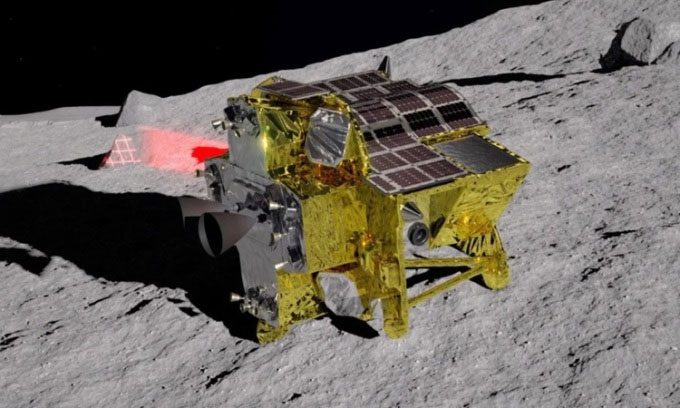Nearly three hours after the lunar landing, Japan’s spacecraft went inactive to await recovery as sunlight reached its solar panels, JAXA reported today.
The Smart Lander for Investigating Moon (SLIM), also known as the Moon Sniper, successfully landed on the Moon at 10:20 PM on January 19 (Hanoi time), making Japan the fifth country to softly land a craft on Earth’s natural satellite. However, after SLIM’s landing, the Japan Aerospace Exploration Agency (JAXA) could not confirm whether the spacecraft’s solar panels were generating electricity.

Simulation of the SLIM spacecraft on the lunar surface. (Photo: JAXA).
Almost three hours after the historic landing, experts “turned off” SLIM to enable the spacecraft to recover as sunlight reached its solar panels. Before shutting down the lander remotely, the mission control station received imagery and technical data from the landing and from the lunar surface.
“We felt relieved and started to get excited after confirming that we had obtained a lot of data. According to remote measurement data, SLIM’s solar panels are facing west. If sunlight hits the Moon from the west in the future, we believe there is a chance to generate energy, and we are preparing for recovery,” JAXA shared.
JAXA disconnected SLIM’s battery just before 1 AM on January 20, when it had about 12% power left, to prevent future difficulties in restarting the spacecraft. The agency is conducting a detailed analysis of the data to determine whether the spacecraft achieved its landing target within 100 meters of the designated location.
SLIM aimed for a depression believed to have a layer of material—deeper layers of the Moon, typically located beneath the crust—exposed on the surface. By analyzing rocks there, JAXA hopes to shed light on the mysteries regarding potential water resources on the Moon. This is a crucial factor for building bases on this celestial body.
The two small robots that SLIM carried were also successfully deployed. One of these robots is equipped with a transmitter, while the other is designed to move around the lunar surface and send images back to Earth. This mini autonomous robot is slightly larger than a tennis ball and can change shape.
Today, JAXA also announced that they are preparing to release further updates this week regarding the mission results and the status of the SLIM spacecraft. According to experts at JAXA, while not everything went as planned, they obtained numerous results and are pleased with the successful landing.
SLIM is one of the new lunar missions being conducted by governments and private companies about five decades after the first human Moon landing. Many spacecraft have crashed and lost communication. To date, besides Japan, only four other countries have successfully landed spacecraft on the Moon, including the United States, the Soviet Union, China, and most recently, India.


















































